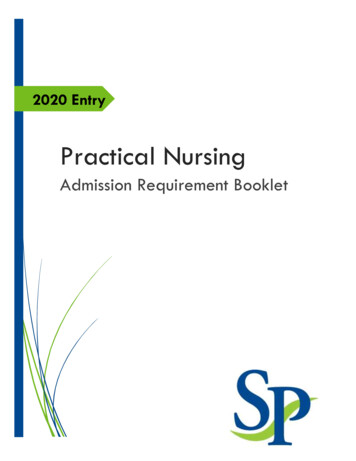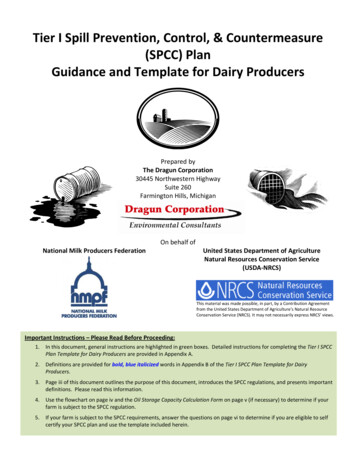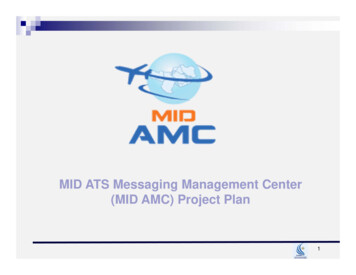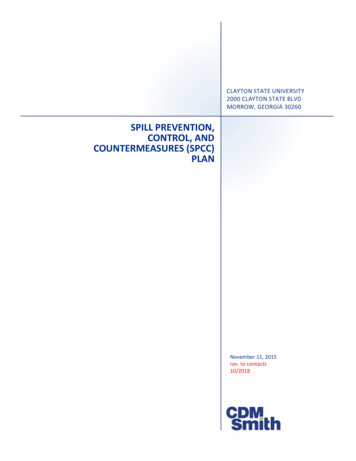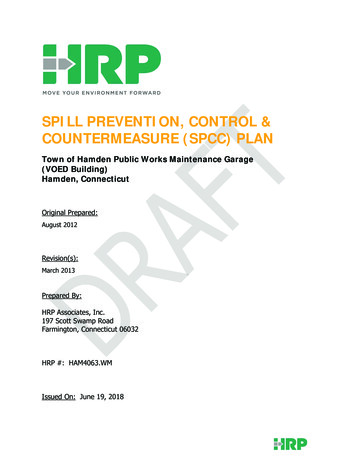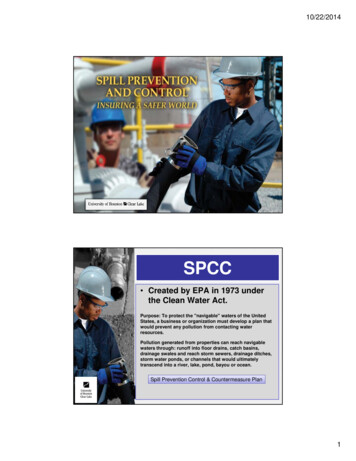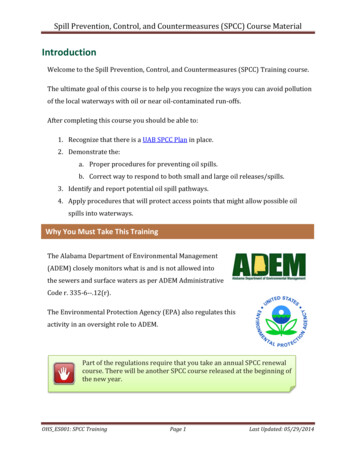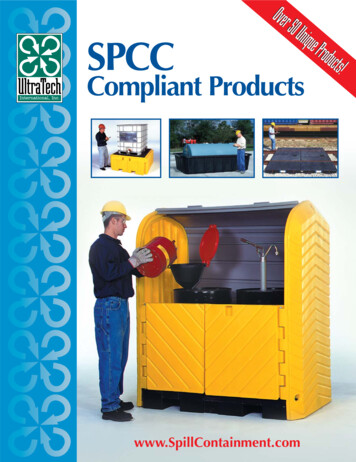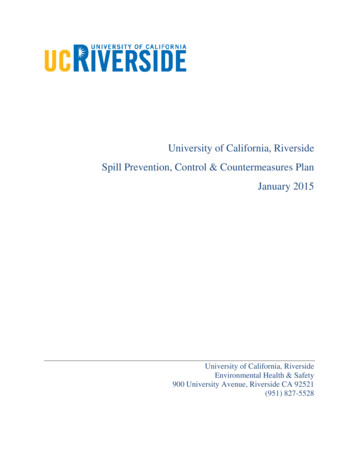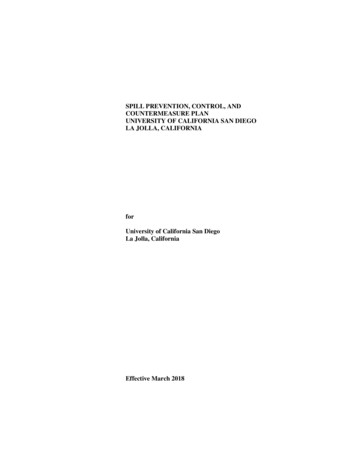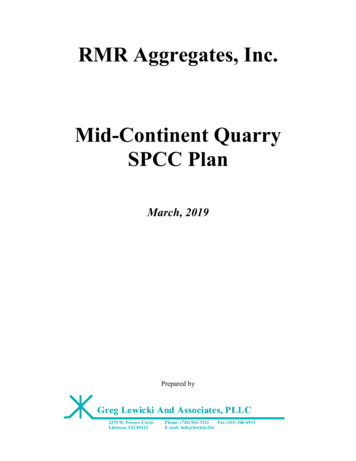
Transcription
RMR Aggregates, Inc.Mid-Continent QuarrySPCC PlanMarch, 2019Prepared by
RMR Aggregates, Inc.3/5/2019TABLE OF CONTENTSPageIntroduction3Part 1: Plan Administration1.1 Management Approval and Designated Person51.2 Professional Engineer Certification61.3 Location of SPCC Plan71.4 Plan Review71.5 Facilities, Procedures, Methods, or Equipment Not Yet Fully Operational81.6 Cross-Reference with SPCC Provisions8Part 2: General Facility Information2.1 Facility Description112.2 Evaluation of Discharge Potential13Part 3: Discharge Prevention – General SPCC Provisions3.1 Compliance with Applicable Requirements143.2 Facility Layout Diagram143.3 Spill Reporting143.4 Potential Discharge Volumes and Direction of Flow143.5 Containment and Diversionary Structures153.6 Practicability of Secondary Containment153.7 Inspections, Tests, and Records163.8 Personnel, Training, and Discharge Prevention Procedures223.9 Security243.10 Tank Truck Loading/Unloading Rack Requirements243.11 Brittle Fracture Evaluation253.12 Conformance with State and Local Applicable Requirements25Part 4: Discharge Prevention – SPCC Provisions for Onshore Facilities(Excluding Production Facilities)4.1 Facility Drainage264.2 Bulk Storage Containers274.3 Transfer Operations, Pumping, and In-Plant Processes32Part 5: Discharge Response5.1 Response to a Minor Spill355.2 Response to a Major Discharge36
RMR Aggregates, Inc.3/5/20195.3 Waste Disposal375.4 Spill Notification Forms and Discharge Notification375.5 Cleanup Contractors and Equipment Suppliers38Appendix A – FiguresAppendix B – Tank Ultrasonic Shell testing protocol
RMR Aggregates, Inc.3/5/2019INTRODUCTIONPurposeThe purpose of this Spill Prevention, Control, and Countermeasure (SPCC) Plan is to describemeasures implemented by RMR Aggregates, Inc. to prevent oil discharges from occurring, and toprepare RMR Aggregates, Inc. to respond in a safe, effective, and timely manner to mitigate the impactsof a discharge.This Plan has been prepared to meet the requirements of Title 40, Code of Federal Regulations,Part 112 (40 CFR part 112).In addition to fulfilling requirements of 40 CFR part 112, this SPCC Plan is used as a referencefor oil storage information and testing records, as a tool to communicate practices on preventing andresponding to discharges with employees, as a guide to facility inspections, and as a resource duringemergency response.RMR Aggregates, Inc. management has determined that this facility does not pose a risk ofsubstantial harm under 40 CFR part 112, as recorded in the “Substantial Harm Determination” includedin this Plan.This Plan provides guidance on key actions that RMR Aggregates, Inc. must perform to complywith the SPCC rule:Complete monthly and annual site inspections as outlined in the Inspection, Tests, and Records sectionof this Plan (Section 3.7) using the inspection checklists. Perform preventive maintenance of equipment, secondary containment systems, and dischargeprevention systems described in this Plan as needed to keep them in proper operating conditions. Conduct annual employee training as outlined in the Personnel, Training, and Spill PreventionProcedures section of this Plan (Section 3.8) and document them on the log. If either of the following occurs, submit the SPCC Plan to the EPA Region 8 Regional Administrator(RA) and the Colorado Department of Public Health and Environment (CDPHE), along with otherinformation as detailed in Section 5 of this Plan:o The facility discharges more than 1,000 gallons of oil into or upon the navigable waters ofthe U.S. or adjoining shorelines in a single spill event; oro The facility discharges oil in quantity greater than 42 gallons in each of two spill eventswithin any 12-month period. Review the SPCC Plan at least once every five (5) years and amend it to include more effectiveprevention and control technology, if such technology will significantly reduce the likelihood of aspill event and has been proven effective in the field at the time of the review. Plan amendments,other than administrative changes discussed above, must be recertified by a Professional Engineer onthe certification page in Section 1.2 of this Plan.3
RMR Aggregates, Inc. 3/5/2019Amend the SPCC Plan within six (6) months whenever where is a change in facility design,construction, operation, or maintenance that materially affects the facility’s spill potential. Therevised Plan must be recertified by a Professional Engineer (PE).Review the Plan on an annual basis. Update the Plan to reflect any “administrative changes” that areapplicable, such as personnel changes or revisions to contact information, such as phone numbers.Administrative changes must be documented in the Plan review log, but do not have to be certified by aPE.4
RMR Aggregates, Inc.3/5/2019Part 1: Plan Administration1.1Management Approval and Designated Person (40 CFR 112.7)RMR Aggregates, Inc. is committed to preventing discharges of oil to navigable waters and theenvironment, and to maintaining the highest standards for spill prevention control and countermeasuresthrough the implementation and regular review and amendment to the Plan. This SPCC Plan has the fullapproval of RMR Aggregates, Inc. management. RMR Aggregates, Inc. has committed the necessaryresources to implement the measures described in this Plan.The Facility Manager is the Designated Person Accountable for Oil Spill Prevention at the facility andhas the authority to commit the necessary resources to implement this Plan.Authorized Facility Representative (facility response coordinator): Robert WagnerSignature:Title:Date:5
RMR Aggregates, Inc.1.23/5/2019Professional Engineer Certification (40 CFR 112.3(d))The undersigned Registered Professional Engineer is familiar with the requirements of Part 112 of Title40 of the Code of Federal Regulations (40 CFR part 112) and has visited and examined the facility, orhas supervised examination of the facility by appropriately qualified personnel. The undersignedRegistered Professional Engineer attests that this Spill Prevention, Control, and Countermeasure Planhas been prepared in accordance with good engineering practice, including consideration of applicableindustry standards and the requirements of 40 CFR part 112; that procedures for required inspectionsand testing have been established; and that this Plan is adequate for the facility. [40 CFR 112.3(d)]This certification in no way relieves the owner or operator of the facility of his/her duty to prepare andfully implement this SPCC Plan in accordance with the requirements of 40 CFR part 112. This Plan isvalid only to the extent that the facility owner or operator maintains, tests, and inspects equipment,containment, and other devices as prescribed in this Plan.1.2.1 Required ImprovementsThe Professional Engineer’s certification of this plan is contingent on the following facilityimprovements being implemented for compliance with SPCC regulations 40 CFR 112:Signature:Name:State and Registration #:Company:Date:6
RMR Aggregates, Inc.1.33/5/2019Location of SPCC Plan (40 CFR 112.3(e))In accordance with 40 CFR 112.3(e)(2), a complete copy of this SPCC Plan is maintained at the RMRAggregates, Inc. headquarters.1.4Plan Review (40 CFR 112.3 and 112.5)1.4.1Changes in Facility ConfigurationIn accordance with 40 CFR 112.5(a), RMR Aggregates, Inc. periodically reviews and evaluates thisSPCC Plan for any change in the facility design, construction, operation, or maintenance that materiallyaffects the facility’s potential for an oil discharge, including, but not limited to: commissioning of containers;reconstruction, replacement, or installation of piping systems;construction or demolition that might alter secondary containment structures; orchanges of product or service, revisions to standard operation, modification oftesting/inspection procedures, and use of new or modified industry standards ormaintenance procedures.Amendments to the Plan made to address changes of this nature are referred to as technical amendments,and must be certified by a PE. Non-technical amendments can be done (and must be documented in thissection) by the facility owner and/or operator. Non-technical amendments include the following: change in the name or contact information (i.e., telephone numbers) of individualsresponsible for the implementation of this Plan; orchange in the name or contact information of spill response or cleanup contractors.RMR Aggregates, Inc. must make the needed revisions to the SPCC Plan as soon as possible, but nolater than six months after the change occurs. The Plan must be implemented as soon as possiblefollowing any technical amendment, but no later than six months from the date of the amendment. TheFacility Manager is responsible for initiating and coordinating revisions to the SPCC Plan.1.4.2Scheduled Plan ReviewsIn accordance with 40 CFR 112.5(b), RMR Aggregates, Inc. reviews this SPCC Plan at least once everyfive years (in the past, such reviews were required every three years). Revisions to the Plan, if needed,are made within six months of the five-year review. A registered Professional Engineer certifies anytechnical amendment to the Plan, as described above, in accordance with 40 CFR 112.3(d). This Plan isdated 3/5/2019. The next plan review is therefore scheduled to take place on or prior to November,2023.1.4.3Record of Plan ReviewsScheduled reviews and Plan amendments are recorded in the Plan Review Log. This log must becompleted even if no amendment is made to the Plan as a result of the review. Unless a technical oradministrative change prompts an earlier review of the Plan, the next scheduled review of this Plan mustoccur by November, 2023.7
RMR Aggregates, Inc.1.53/5/2019Facilities, Procedures, Methods, or Equipment Not Yet Fully Operational (40 CFR 112.7)Bulk storage containers at this facility have never been tested for integrity since their installation.Section 4.2.6 of this Plan describes the inspection program to be implemented by the facility following aregular schedule, including the dates by which each of the bulk storage containers must be tested.1.6Cross-Reference with SPCC Provisions (40 CFR 112.7)This SPCC Plan does not follow the exact order presented in 40 CFR part 112. Section headingsidentify, where appropriate, the relevant section(s) of the SPCC rule. Table 1-2 presents a crossreference of Plan sections relative to applicable parts of 40 CFR part 112.8
RMR Aggregates, Inc.3/5/2019Table 1-1: Plan Review Writing planScopeInitial SPCC Plan ial SPCC planPE NameBen Langenfeld9Licensing State andRegistration #CO 0047151
RMR Aggregates, Inc.Provision3/5/2019Table 1-2: SPCC Plan Cross-Reference with CFRPlan SectionPage112.3(d)Professional Engineer Certification112.3(e)Location of SPCC Plan7112.5Plan Review7112.7Management Approval5112.7Cross-Reference with SPCC Rule112.7(a)(3)Site Plan and Facility Diagram112.7(a)(4)Discharge Notification37112.7(a)(5)Part 5: Discharge Response34112.7(b)14112.7(c)3.4 Potential Discharge Volumes and Directionof Flow3.5 Containment and Diversionary Structures112.7(d)3.6 Practicability of Secondary Containment15112.7(e)3.7 Inspections, Tests, and Records16112.7(f)22112.7(g)3.8 Personnel, Training and DischargePrevention Procedures3.9 Security112.7(h)3.10 Tank Truck Loading/Unloading24112.7(i)3.11 Brittle Fracture Evaluation25112.7(j)25112.8(b)3.12 Conformance with Applicable State andLocal Requirements4.1 Facility Drainage112.8(c)(1)4.2.1 Construction28112.8(c)(2)4.2.2 Secondary Containment28112.8(c)(3)4.2.3 Drainage of Diked Areas28112.8(c)(4)4.2.4 Corrosion Protection28112.8(c)(6)4.2.6 Inspection - Facility Inspection Checklists29112.8(c)(8)4.2.8 Overfill Prevention System32112.8(c)(10)4.2.10 Visible Discharges321061014 and Appendix A152426
RMR Aggregates, Inc.3/5/2019Part 2: General Facility InformationName:RMR Aggregates, Inc., Inc.Address:Mid-Continent Quarry1001 Transfer TrailGlenwood Springs 81601Type:Limestone QuarryDate of Initial Operations:2019 (SPCC start up)Owner/Operator:RMR Aggregates, Inc.4601 DTC Blvd, Suite 130,Denver, CO 80237720-614-5213Robert WagnerWork: 720-614-5213Cell (24 hours):Primary contact:2.1Facility Description (40 CFR 112.7(a)(3))2.1.1Location and ActivitiesThe Mid-Continent Quarry is a limestone quarry operation located 2 miles north of Glenwood Springs,Colorado. The limestone deposit is approximately 175 feet thick is overlain by soil and overburdenranging from 0 to 48 inches. The entire operation takes place within the limestone deposit, which sitsatop the hill knob located between Cascade and Oasis Creeks.Mining activity consists of drilling and blasting a limestone deposit followed by crushing the material tospecific sizes for sale. Primary crushing and screening on the active mining bench is portable and movesthroughout the site as active mining moves across the site. Secondary processing takes place in the millbuilding on the mill level.The operations at the Mid-Continent Quarry involve the use of numerous diesel powered mobileequipment. Therefore large quantities of off-highway diesel are stored on site.11
RMR Aggregates, Inc.2.1.23/5/2019Oil and Fuel StorageThe capacities of oil containers present at the site are listed below and are also indicated on Map C-4and Map C-6. The 10,000 gallon tanks are located at the fuel farm on the Mill Level (Map C-4). The2,000 gallon tank is located on the active mining bench (Map C-6).Table 2-1: Oil ContainersIDDB1DB2ContentOff-road dieselOff-road dieselSize10,000 gallon10,000 gallonDB3Off-road diesel2,000 gallonLocationMill LevelMill LevelActive MiningBenchSecondary ContainmentDouble Wall TankDouble Wall TankDouble Wall TankOther Containers:1. Various other tanks associated with mobile equipment used for the sole purpose of motivepower. These tanks are not regulated under the SPCC rule. See 40 CFR 112.1(d)(2)(ii)(B)12
RMR Aggregates, Inc.3/5/20192.2Evaluation of Discharge Potential2.2.1Distance to Navigable Waters and Adjoining Shorelines and Flow PathsThe facility is located roughly a mile north of the Colorado River. An unnamed drainage south of themill level is what the entire facility drains to. Oasis Creek is 2000 feet to the west and Cascade Creek is450 feet to the east. Both creek drainages are separated from the facility topographically by ridgelines orby runoff control structures implemented during operations.2.2.2Discharge HistoryTable 2-1 summarizes the facility’s discharge history.Table 2-2: Oil Discharge HistoryDescription of DischargeCorrective Actions TakenNone13Plan for PreventingRecurrence
RMR Aggregates, Inc.3/5/2019PART 3: Discharge Prevention - General SPCC ProvisionsThe following measures are implemented to prevent oil discharges during the handling, use, or transferof oil products at the facility. Oil-handling employees have received training in the properimplementation of these measures.3.1Compliance with Applicable Requirements (40 CFR 112.7(a)(2))All oil containing tanks are either double-walled (DB1, 2, & 3) or located within a storage container forsecondary containment (all 55 gallon drums).3.2Facility Layout Diagram (40 CFR 112.7(a)(3))Maps C-4 and C-6 show the locations of the mill level fuel farm (2-10,000 gallon tanks) and the 2,000gallon tank located on the active mining bench. As required under 40 CFR 112.7(a)(3), the facilitydiagram indicates the location and content of AST.3.3Spill Reporting (40 CFR 112.7(a)(4))The discharge notification form will be completed upon detection of a discharge by the EnvironmentalManager and prior to reporting a spill to the proper notification contacts.3.4Potential Discharge Volumes and Direction of Flow (40 CFR 112.7(b))Table 3-1 presents expected volume, discharge rate, general direction of flow in the event of equipmentfailure, and means of secondary containment for different parts of the facility where oil is stored, used,or handled.3.4.1 Tank LabelingAll tanks with a capacity of ten barrels or greater will be labeled with the following information: nameof operator, operator’s emergency contact telephone number, tank capacity, tank contents, and NationalFire Protection Association (NFPA) label. Smaller tanks will be labeled with contents and NFPA label14
RMR Aggregates, Inc.3/5/2019Table 3-1: Potential Discharge Volumes and Direction of FlowPotential EventFailure of abovegroundtank (collapse orpuncture below productlevel)Tank mdischargeDirection ofrateFlowGradual toVariesinstantaneousSecondary ContainmentDouble-walled tanks1 to 12060 gal/minVariesPipe failure10050 gal/minVariesLeaking pipe or valvepacking1001 gal/minVariesLand-based spill responsecapability (spill kit)Diesel dispenser hose/connections leak1 to 15030gal/minuteVariesLand-based spill responsecapability (spill kit)Leak or failure of drum1 to 553.5Gradual toVariesinstantaneousSite berms and sitetopographyLand-based spill responsecapability (spill kit)Storage container wallsContainment and Diversionary Structures (40 CFR 112.7(c))Methods of secondary containment at this facility include a combination of structures (e.g., berm andsite topography) and land-based spill response (e.g., sorbents) to prevent oil from reaching the nearestdrainage. The capacities of the containment are shown in Table 2-1. For bulk storage containers (refer to Section 4.2.2 of this Plan): 3.6All double walled tanks.In transfer areas and other parts of the facility where a discharge could occur: Drip pans. Fill ports for all ASTs are equipped with drip pans to contain smallleaks from the piping/hose connections. Sorbent material. a Spill cleanup kit of at least 90 gallons or more that includeabsorbent material, booms, and other portable barriers is located near the FB1Tank. The spill kit is located within close proximity of the oil product storage andhandling areas for rapid deployment should a spill occur.Practicability of Secondary Containment (40 CFR 112.7(d))RMR Aggregates, Inc. management has determined that secondary containment is practicable at thisfacility.15
RMR Aggregates, Inc.3.73/5/2019Inspections, Tests, and Records (40 CFR 112.7(e))As required by the SPCC rules, RMR Aggregates, Inc. performs the inspections, tests, and evaluationslisted in the following Table 3-2. The table summarizes the various types of inspections and testsperformed at the facility. The inspections and tests are described later in this section, and in therespective sections that describe different parts of the facility (e.g., Section 4.2.6 for bulk storagecontainers).16
RMR Aggregates, Inc.3/5/2019Table 3-2: Inspection and Testing cesAbovegroundTest container integrity bycontainer with all conducting visual inspection. Inspectsides visibleoutside of container for signs ofdeterioration and discharges.Following a regular schedule (monthly,annual, and during scheduledinspections) and whenever materialrepairs are made.Containersupports andfoundationInspect container’s supports andfoundations.Following a regular schedule (monthly,annual, and during scheduledinspections) and whenever materialrepairs are made.Liquid levelsensing devices(overfill)Test for proper operation.MonthlyDiked area, lined Inspect for signs of deterioration,berms and sitedischarges, or accumulation of oilbermsinside diked areas.MonthlyVisually inspect content for presence Prior to drainingof oil.All abovegroundvalves, piping,andappurtenancesAssess general condition of items,Monthlysuch as flange joints, expansionjoints, valve glands and bodies, catchpans, pipeline supports, locking ofvalves, and metal surfaces.Buried pipingInspect for deterioration.Whenever a section of buried line isexposed for any reason.Integrity and leak testing.At the time of installation,modification, construction, relocation,or replacement.Note: If any above ground container is added to the site at a later date, where all sides are not visible,alternative testing requirements will be needed and the plan will need to be modified.All secondary containment will be inspected following a rainstorm and pumped out as needed.3.7.1Daily InspectionA RMR Aggregates, Inc. employee performs a complete walk-through of the facility each day duringnormal operation. This daily visual inspection involves: looking for tank/piping damage or leakage,stained or discolored soils, or excessive accumulation of water in the containment. All types ofsecondary containment should be visually checked for damage.17
RMR Aggregates, Inc.3.7.23/5/2019Monthly InspectionThe checklist provided is used for monthly inspections by RMR Aggregates, Inc. personnel. Theseinspections will only be conducted when the quarry is in operation. The table below shows the operatingdates of the quarry. The monthly inspections cover the following key elements: Observing the exterior of aboveground storage tanks, pipes, and other equipment for signs ofdeterioration, leaks, corrosion, and thinning.Observing the exterior of portable containers for signs of deterioration or leaks.Observing tank foundations and supports for signs of instability or excessive settlement.Observing the tank fill and discharge pipes for signs of poor connection that could cause a discharge,and tank vent for obstructions and proper operation.Verifying the proper functioning of overfill prevention systems.Checking the inventory of discharge response equipment and restocking as needed.Check all types of secondary containment on site for damage.All problems regarding tanks, piping, containment, or response equipment must immediately be reportedto the Facility Manager. Visible oil leaks from tank walls, piping, or other components must be repairedas soon as possible to prevent a larger spill or a discharge to navigable waters or adjoining shorelines.Pooled oil is removed immediately upon discovery. The Monthly Inspection Checklist is included in thissection and the inspection will be conducted during normal operation of the site.Written monthly inspection records are signed by the Facility Manager and maintained with this SPCCPlan for a period of three years.StartupDateShutdownDateLocation18Notes
RMR Aggregates, Inc.3/5/2019Monthly Inspection ChecklistThis inspection record must be completed each month except the month in which an annual inspection isperformed or during normal site closure. Provide further description and comments, if necessary, on aseparate sheet of paper and attach to this sheet. *Any item that receives “yes” as an answer must bedescribed and addressed immediately.Y*NDescription & CommentsStorage tanksTank surfaces show signs of leakageTanks are damaged, rusted or deterioratedTank supports are deteriorated or buckledTank foundations have eroded or settledLevel gauges or alarms are inoperativeVents are obstructedPrecipitation present in secondary containmentSecondary containment is damaged or stainedSite berms are DamagedPipingValve seals, gaskets, or other appurtenances are leakingPipelines or supports are damaged or deterioratedJoints, valves and other appurtenances are leakingBuried piping is exposedLoading/unloading and transfer equipmentConnections are not capped or blank-flangedSecurityFencing, gates, or lighting is non-functionalPumps and valves are locked if not in useResponse EquipmentDate:Signature:19
RMR Aggregates, Inc.3.7.33/5/2019Annual InspectionFacility personnel perform a more thorough inspection of facility equipment on an annual basis. Thetable below shows the operational periods for this quarry This annual inspection complements themonthly inspection described above and is performed in March of each year using the checklistprovided. The Annual Inspection Checklist is included in this section.The annual inspection is preferably performed after a large storm event in order to verify theimperviousness and/or proper functioning of drainage control systems such as the site berms, concretelined dikes, lined berms and control valves.Written annual inspection records are signed by the Facility Manager and maintained with this SPCCPlan for a period of three years.StartupDateShutdownDateLocation20Inspection Date
RMR Aggregates, Inc.3/5/2019Annual Inspection ChecklistThis inspection record must be completed each year. Provide further description and comments, ifnecessary, on a separate sheet of paper and attach to this sheet. *Any item that receives “yes” as ananswer must be described and addressed immediately.Y*NDescription & CommentsStorage tanksTank surfaces show signs of leakageTanks are damaged, rusted or deterioratedTank supports are deteriorated or buckledTank foundations have eroded or settledLevel gauges or alarms are inoperativeVents are obstructedPrecipitation present in secondary containmentSecondary containment is damaged or stainedPipingValve seals, gaskets, or other appurtenances are leakingPipelines or supports are damaged or deterioratedJoints, valves and other appurtenances are leakingBuried piping is exposedLoading/unloading and transfer equipmentConnections are not capped or blank-flangedSecondary ContainmentSite berm is not preventing dischageConcrete Bunker is damaged or stainedSecurityFencing, gates, or lighting is non-functionalPumps and valves are locked if not in useResponse EquipmentResponse equipment inventory is completeDate: Yr: Signature:Annual reminders:*Hold SPCC Briefing for all oil-handling personnel (and update briefing log in the Plan);*Check contact information for key employees and response/cleanup contractors and update themin the Plan as needed;21
RMR Aggregates, Inc.3.7.43/5/2019Periodic Integrity TestingIn addition to the above monthly and annual inspections by facility personnel, tank integrity is verifiedwith the leak detection system. Leak detection systems consist of an interstitial monitoring deviceinstalled in the double-walled tanks. These maybe automatic electronic sensors or manual visualmonitors. If the interstitial monitor is a manual visual one, it is to be checked a minimum of once amonth.3.8Personnel, Training, and Discharge Prevention Procedures (40 CFR 112.7(f))The Facility Manager is the facility designee and is responsible for oil discharge prevention, control, andresponse preparedness activities at this facility.RMR Aggregates, Inc. management has instructed oil-handling facility personnel in the operation andmaintenance of oil pollution prevention equipment, discharge procedure protocols, applicable pollutioncontrol laws, rules and regulations, general facility operations, and the content of this SPCC Plan. Anynew facility personnel with oil-handling responsibilities are provided with this same training prior tobeing involved in any oil operation.Annual discharge prevention briefings are held by the Facility Manager for all facility personnelinvolved in oil operations. The briefings are aimed at ensuring continued understanding and adherenceto the discharge prevention procedures presented in the SPCC Plan. The briefings also highlight anddescribe known discharge events or failures, malfunctioning components, and recently implementedprecautionary measures and best practices. Facility operators and other personnel will have theopportunity during the briefings to share recommendations concerning health, safety, and environmentalissues encountered during facility operations.Records of the briefings and discharge prevention training are kept on the Training Form and maintainedwith this SPCC Plan for a period of three years.22
RMR Aggregates, Inc.3/5/2019Record of Annual Discharge Prevention Training FormBriefings and TrainingBriefings will be scheduled and conducted by the facility owner or operator for operating personnel atregular intervals to ensure adequate understanding of this SPCC Plan. The briefings will also highlightand describe known discharge events or failures, malfunctioning components, and recently implementedprecautionary measures and best practices. Personnel will also be instructed in operation andmaintenance of equipment to prevent the discharge of oil, and in applicable pollution laws, rules, andregulations. Facility operators and other personnel will have an opportunity during the briefings to sharerecommendations concerning health, safety, and environmental issues encountered during facilityoperations.DateSubjects CoveredEmployees in Attendance23Instructor(s)
RMR Aggregates, Inc.3.93/5/2019Security (40 CFR 112.7(g))RMR Aggregates, Inc. takes steps at each site to ensure they are safe and secure. Gates on access roadswill be the primary security measure. The quarry will also be operating 24 hours a day, with personnelconstantly present on site.3.10Tank Truck Loading/Unloading Rack Requirements (40 CFR 112.7(h))The potential for discharges during tank truck loading and unloading operations is addressed at eachfacility using site berms. RMR Aggregates, Inc. management is committed to ensuring the safe transferof material to and from storage tanks. The following measures are implemented to prevent oil dischargesduring tank truck loading and unloading operations.3.10.1 Secondary Containment (40 CFR 112.7(h)(1))All drums and tanks have secondary containment. The containment consists of structures directly aroundthe tanks (double-walled, berms, etc.) and the site berm which is the end of the flow path. The quarryhas sufficient capacity to collect all tank capacity plus precipitation. All loading areas have drip pans tobe used during the disconnection of transfer hoses.Secondary containment will always be sized to have a volume of 110% of the largest tank or drumstored in said secondary containment. Such secondary containment volume will be confirmed prior tofilling any tank or drum to be stored within.3.10.2 Loading/Unloading Procedures (40 CFR 112.7
Table 1-2: SPCC Plan Cross-Reference with CFR . Provision Plan Section Page. 112.3(d) Professional Engineer Certification 6 112.3(e) Location of SPCC Plan 7 112.5 Plan Review 7 112.7 Management Approval 5 112.7 Cross-Reference with SPCC Rule 10 112.7(a)(3) Site Plan and Facility Diagram 14 and Appendix A 112.7(a)(4) Discharge Notification 37
